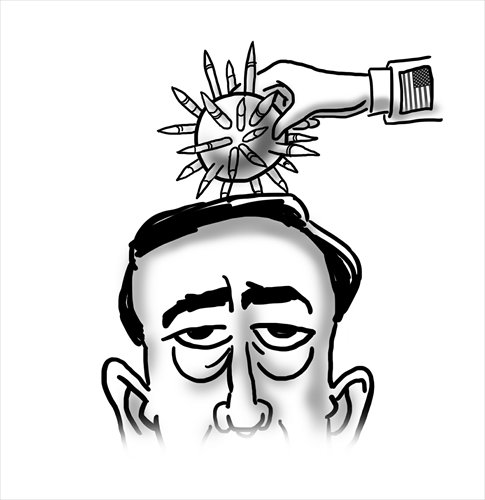HOME >> OP-ED
THAAD will trigger instability in S.Korea
By Lü Chao Source:Global Times Published: 2016/8/1 18:18:40

Illustration: Liu Rui/GT
Ever since Washington and Seoul announced the deployment the Terminal High-Altitude Area Defense (THAAD) system in Seongju county, South Korea, fierce debates have been unfolding over pros and cons of THAAD deployment within South Korean political circles and the media. Some Korean citizens have also protested, especially locally. It is worth noting that those politicians and common people who opposed the decision at early stage are now pointing their finger at the chief plotter of THAAD deployment - the US government. And pro-US forces within South Korean conservatives blame China for the outbreak of the anti-THAAD demonstrations.
The US has subsidized every cost of THAAD deployment in South Korea, including the purchase of the system, and sending US military to the nation to operate it. Washington has even made an exception in enabling South Korean groups to visit US military base in Guam, where THAAD has already been placed. In order to dispel the doubt from South Koreans over supposed radiation caused by THAAD, US Representative Trent Franks claimed that "I would want THAAD outside in our backyard."
It is however hard to connect the rare "enthusiasm" and "generosity" of the US with the intention of safeguarding Seoul's peace, security and prosperity. The US government actually has its own calculations in deploying THAAD on South Korea.
To begin with, Washington's rebalance to Asia-Pacific strategy is not going smoothly. US President Barack Obama is hoping to make some achievements in the region as his second term runs out. Deploying THAAD right after the South China Sea arbitration result was released, pilling pressure on Beijing from both south and north, is wishful thinking by the US.
If THAAD can be smoothly installed in South Korea, missile forces in northern China and Russia's Far East will be exposed to most advanced radar. The military strategic balance in Northeast Asia will hence be disrupted, and will develop favorably for the US.
The foundation for Washington to maintain its political, economic and military interests in Asia is its alliance with Tokyo and Seoul. Yet over the recent years, Obama cannot stand that the government of South Korean President Park Geun-hye has been moving closer to China while being at loggerheads with Japan regardless of the US attitude. The US will not allow any weak link in its alliance. In this case, deploying THAAD in South Korea will immediately break the close relationship between Beijing and Seoul, win applause from Japan, and intensify US military deterrence against China, Russia and North Korea. Washington will thus kill three birds with one stone.
Does the US really want to protect South Korea's security and the Korean Peninsula's stability by deploying THAAD? If so, as Beijing and Moscow firmly oppose the deployment and may adopt military countermeasures, and Pyongyang also responds with claims of physical strikes, will Seoul ever be more secure? THAAD is not capable of protecting South Korea from artillery shells, rocket shells, short-range missiles and submarine-launched missiles, and it excludes Seoul from its defensive range. In this case, how can THAAD bring South Korea any sense of security?
Of course, it takes two to dance. The US alone cannot forcefully make THAAD deployment work. The ruling Saenuri Party in South Korea has been firmly promoting the deployment of the US-built missile defense system, while the South Korean government has been spreading that those who are against THAAD are so-called "external forces" and illegal agents, in order to hit the opposition party in next year's elections.
However, THAAD deployment will trigger political instability in South Korea, affect the country's economic development, and forcing the nation to reshuffle its foreign policy. By then the Blue House will have to eat its own bitter fruit. Hence, the wisest choice is to give up THAAD.
The author is a professor with the Liaoning Academy of Social Sciences. opinion@globaltimes.com.cn
Posted in: Asian Review